Papers by JOELMA QUEIROZ ANDRADE
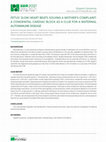
SBR 2021 Congresso Brasileiro de Reumatologia, 2021
BACKGROUND Neonatal lupus is a rare autoimmune disease characterized by passive transfer of antib... more BACKGROUND Neonatal lupus is a rare autoimmune disease characterized by passive transfer of antibodies such as anti-Ro/SSA or anti-La/ SSB across the placenta to the fetal circulation causing clinical manifestations in the neonate, regardless of maternal illness. The most serious complication is congenital heart block (CHB). The disease causes 80-95% of the severe atrioventricular blocks in the neonatal period. Treatment varies according to the degree of block, despite limited data. Second-degree CHB is treated with fluorinated corticosteroids and/or intravenous immunoglobulin. Complete blocks are not reversible and there is no indication for therapies, except when there is extranodal disease. Most pregnant women are asymptomatic at diagnosis of CHB. Sjögren's syndrome was diagnosed during pregnancy or less than 12 months after delivery in 14% of mothers in a case series of 49 women with fetuses with CHB. CASE REPORT A 37-year-old woman (gestational age of 31 weeks) was admitted with a history of complete CHB since 18 weeks, in addition to severely restricted intrauterine growth (< 3rd percentile). Laboratory workup showed positive anti-Ro in high titers (> 240 U/mL), positive anti-La (18 U/mL), positive ANA (nuclear large/coarse speckled 1/320), normal serum complement levels and negative antiphospholipid antibodies. Dexamethasone 4 mg/day was started at 20 weeks in an outpatient service due to autoimmune CHB. Patient reported previous uneventful pregnancy 4 years before and recent diagnosis of subclinical hypothyroidism. She also reported xerophthalmia for 10 years, under chronic use of lubricating eye drops. There were no other complaints or laboratory alterations. On ophthalmologic examination, a 0 mm Schirmer's test bilaterally, normal salivary flow, anterior and posterior blepharitis 3+/4, tear film break time of 3 s in right eye and 2 s in left eye, bad tear film distribution, lacrimal meniscus absent 3 min after fluorescein instillation and Inferior punctate keratitis in both eyes. Minor salivary gland biopsy showed chronic lymphocytic sialadenitis (focus score of 2). Therefore, she was diagnosed with primary Sjögren's syndrome, prescribed lubricating eye drops every hour and progressive reduction of corticosteroids (complete CHB without extranodal disease). CONCLUSION This case reported highlights that identification of fetal atrioventricular block raises the need for investigation of maternal autoimmune diseases.
The prognosis of patients with juvenile dermatomyositis (JDM) has improved, allowing adolescents ... more The prognosis of patients with juvenile dermatomyositis (JDM) has improved, allowing adolescents and young adults to have an increased chance of sexual activities and pregnancy. From 1983 to 2004, 4,638 patients were followed at the Pediatric ...
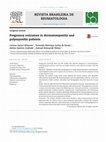
Revista Brasileira de Reumatologia, 2015
Background: Currently, there are few studies that describe pregnancy in dermatomyositis/polymyosi... more Background: Currently, there are few studies that describe pregnancy in dermatomyositis/polymyositis patients, and they are largely limited to case reports or studies with few samples. Objectives: Therefore, we describe the pregnancy in a large sample of patients with dermatomyositis/polymyositis and to analyze the outcomes in those who became pregnant during or after disease onset. Methods: The present single-center study analyzed 98 female patients with idiopathic inflammatory myopathies (60 dermatomyositis and 38 polymyositis patients). They were interviewed to obtain obstetric antecedent and demographic data from June 2011 to June 2012. Results: Seventy-eight (79.6%) of the 98 patients had obstetric histories. Six polymyositis and 9 dermatomyositis patients became pregnant after disease onset. The pregnancy outcomes in these cases were good, except in the following cases: 1 disease reactivation, 1 intrauterine growth retardation, 1 diabetes mellitus, 1 hypertension, 1 hypothyroidism, and 2 fetal losses (same patient). Moreover, 2 patients developed dermatomyositis during pregnancy and 4 (2 polymyositis and 2 dermatomyositis) during the postpartum period with good control after glucocorticoid and immunosuppressant therapy. Conclusions: The adverse obstetric events were related to clinical intercurrences and the pregnancy does not seem to carry a worse prognosis specifically in disease (for example: disease relapsing). Moreover, dermatomyositis or polymyositis onset during pregnancy or the postpartum period had good outcome after drug therapy.
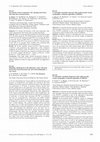
Ultrasound in Obstetrics & Gynecology, 2012
Objectives: To analyze the duration of the atrio-ventricular valve (AVV) opening time and closure... more Objectives: To analyze the duration of the atrio-ventricular valve (AVV) opening time and closure time in normal fetal hearts. Methods: This cross-sectional study included 67 normal fetuses aged 18 to 38 weeks' gestation. The following time intervals were taken: Rt-AVV-O; from the opening of right AVV to its closure, Rt-AVV-C; from the closure of right AVV to its opening, Lt-AVV-O; from the opening of left AVV to its closure, Lt-AVV-C; from the closure of left AVV to its opening. These variables were correlated with gestational age and fetal heart rate in normal fetuses. Results: All of the variables except Lt-AVV-C showed positive correlation with gestational age (Spearman's rank correlation coefficient: Rt-AVV-O; 0.423, Lt-AVV-O; 0.674 and Rt-AVV-C; 0.389). In regard of fetal heart rate, negative correlation were found in all of the variables (Rt-AVV-O: −0.689, Lt-AVV-O: −0.789, Rt-AVV-C: −0.425 and Lt-AVV-C: −0.259). Conclusions: This study firstly showed gestational changes of time interval of AVV-O and AVV-C in uncomplicated fetuses. In addition, different evolution in right and left heart was suggested in fetal life.
Rev Ginecol Obstet, Sep 1, 1996
We present a case of microcephaly associated with Zika virus (ZIKV) in a chronological, multimoda... more We present a case of microcephaly associated with Zika virus (ZIKV) in a chronological, multimodal imaging approach, illustrating the hallmarks of this disease on intrauterine morphological ultrasound, transfontanelar ultrasound, computed tomography (CT) and magnetic resonance imaging (MRI). We also determined the serological e immunological status of the mother and newborn. Noticeably, there was evidence for maternal infection by ZIKV, cytomegalovirus (CMV), herpes simplex virus (HSV), dengue virus (DENV) and Toxoplasma gondii, which indicates a possible role of previous exposures to STORCH agents and possibly comorbidities in the severe fetal congenital manifestation.

Ultrasound in Obstetrics and Gynecology, 2002
ABSTRACT Exencephaly is characterized by a complete or partial absence of the skull&#39;cap, ... more ABSTRACT Exencephaly is characterized by a complete or partial absence of the skull&#39;cap, follwed by abnormal development of the cerebral tissue.We report a case of a 31-year-old, white patient, on the 9th. week of her second gestation who presented with fever, coryza and myalgia. The gestational period was calculated based on the first ultrasonography, and the maternal sorology for rubella was positive (IgG and IgM).The patient was send to the department of Fetal Medicine-HCFMUSP for evaluation. Morphologic ultrasonography and another sorology for rubella were performed. On the 12th gestation week, ultrasonography revealed absence of the skullcap and the presence of cerebral tissue floating in the amniotic fluid. Maternal sorology still showed positive (IgG and IgM). The patient suffered a miscarriage and the maternal (fetus and placenta) was analyzed at the Virology Department of Adolfo Lutz Institute. The virus of rubella was isolated in all the examined organs, and the presence of congenital rubella was confirmed.Considering that the etiology of this malformation is still umknown and is associated with a severe congenital infection we speculate that is coul be a consequence of the massive fetal compromise caused by the rubella virus.
Jornal Brasileiro de Patologia e Medicina Laboratorial, 2008
Human parvovirus B19 infection is known to be one of the causes of hydrops fetalis. The maternal ... more Human parvovirus B19 infection is known to be one of the causes of hydrops fetalis. The maternal infection caused by the virus may be symptomatic or asymptomatic. In this study, 40 pregnant women with gestational age of approximately 25 weeks, prenatal diagnosis of non immune hydrops fetalis and suspected of human parvovirus B19 infection were studied between January 1999 and December 2005. Serology results and detection of DNA in the maternal serum, foetal serum and amniotic fluid confirmed that 20 pregnant women had been infected by human parvovirus B19. The ultrasound examination demonstrated foetal hydrops, anaemia, hepatosplenomegaly, ascites, cardiopathy and amniotic fluid disorders. Among the positive cases, there were three fatal losses, one by miscarriage and two by intrauterine foetal death.
Revista Brasileira de Ginecologia e Obstetrícia, 2002
Revista Brasileira de Reumatologia, 2005
International Journal of Pediatric Otorhinolaryngology, 2008
Ultrasound in Obstetrics and Gynecology, 2008
Poster abstracts cyst highlighting pre-natal diagnosis, perinatal management and the accuracy of ... more Poster abstracts cyst highlighting pre-natal diagnosis, perinatal management and the accuracy of the imaging modalities.
Ultrasound in Obstetrics and Gynecology, 2006
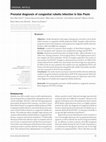
Prenatal Diagnosis, 2003
Objective: rubella during the early stages of pregnancy can lead to severe birth defects known as... more Objective: rubella during the early stages of pregnancy can lead to severe birth defects known as congenital rubella syndrome (CRS). Samples collected from pregnant women with symptoms and suspected of congenital rubella infection between 1996 and 2008 were analyzed. Methods: a total of 23 amniotic fluid samples, 16 fetal blood samples, 1 product of conception and 1 placenta were analyzed by serology and RT-PCR. Results: all patients presented positive serology for IgG / IgM antibodies to rubella virus. Among neonates, 16 were IgG-positive, 9 were IgM-positive and 4 were negative for both antibodies. Of the 25 samples analyzed in this study, 24 were positive by RT-PCR. Changes in ultrasound were found in 15 (60%) of 25 fetuses infected with rubella virus. Fetal death and miscarriage were reported in 10 (40%) of the 25 cases analyzed. The rubella virus was amplified by PCR in all fetuses with abnormal ultrasound compatible with rubella. Fetal death and abortion were reported in 10 of 25 cases analyzed. Conclusion: this study, based on primary maternal rubella infection definitely confirms the good sensitivity and specificity of RT-PCR using amniotic fluid and ultrasound. The results showed that molecular assays are important tools in the early diagnosis of rubella and congenital rubella syndrome.
Journal of Medical Virology, 2011
The incidence of CRS and CRI has decreased markedly worldwide with the implementation of efficien... more The incidence of CRS and CRI has decreased markedly worldwide with the implementation of efficient vaccination programs. We report a congenital rubella case with fetal death occurred at 29th week of gestation. RV was confirmed in placenta. The results of phylogenetic analysis showed that the RVs/Sao-Paulo01.-BRA/08.CRI belongs to the genotype 2B of RV.
Journal of Medical Virology, 2013
Rubella virus (RV) infection during the early stages of pregnancy can lead to serious birth defec... more Rubella virus (RV) infection during the early stages of pregnancy can lead to serious birth defects, known as congenital rubella syndrome (CRS). This retrospective study was conducted between 1996 and 2009 with surveillance specimens collected from patients suspected of congenital rubella infection (CRI) and CRS. The clinical samples (nine amminiotic fluid, eight urine, eight blood, one conception product, and one placenta) were sent for viral isolation and genotyping. Twenty-seven sequences were analysed and four genotypes (1a, 1B, 1G, and 2B) were identified in Sã o Paulo that were involved in congenital infection. To our knowledge, this study is the first report that describes genetic diversity of the circulating rubella strains involved in CRI.
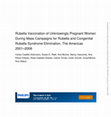
Journal of Infectious Diseases, 2011
Background. Due to the significant teratogenicity of rubella virus and the use of a live-attentua... more Background. Due to the significant teratogenicity of rubella virus and the use of a live-attentuated vaccine, pregnancy is a contraindication of receipt of rubella vaccine (RCV). Data collected from several countries that have observed susceptible women who had received RCV during pregnancy documented that no infant with congenital rubella syndrome (CRS) has been born, so the risk is theoretical. As part of the regional initiative to eliminate rubella and CRS in the Americas, one of the key strategies was the vaccination of women of childbearing age. The implementation of mass vaccination campaigns targeting women of childbearing age in Argentina, Brazil, Costa Rica, Ecuador, El Salvador, and Paraguay provided an opportunity to further increase the body of knowledge on the safety of rubella vaccine if an unknowingly pregnant woman is vaccinated in early pregnancy. Methods. Using a standard protocol, women who were unknowingly pregnant or become pregnant #30 days after receiving RCV were evaluated to determine immunity status (eg, susceptible, immune, and unknown) at the time of vaccination. Susceptible pregnant women were observed to determine the outcome of the pregnancy. For pregnancies that resulted in live births, serum samples were obtained from the newborn for rubella immunoglobulin (Ig) M antibody testing. If the newborn's serum sample was IgM positive, the infant was evaluated for manifestations of CRS. Results. During the period 2001-2008, 48 748 253 women of childbearing age were vaccinated in the region of the Americas, 39 542 253 (81%) of whom were vaccinated in the 6 selected countries. Of these women, 30 139 (0.07%) were pregnant or became pregnant #1 month after receiving vaccine and were followed up. On the basis of serological evaluation, 2894 (10%) women were classified as susceptible at the time of vaccination; of their pregnancies, 1980 (90%) resulted in a live birth. Sera from 70 (3.5%) of these infants were rubella IgM antibody positive, but none of the infants had features of CRS as a result of rubella vaccination. The maximum theoretical risk for CRS following rubella vaccination of susceptible pregnant women was 0.2%. Conclusions. The results of these studies from 6 select countries provides additional evidence showing an absence of risk of CRS associated with administering rubella vaccine shortly before or during pregnancy. Rubella, first described in the late 18th century, was initially thought to be a benign disease; however, in 1941, Sir Norman Gregg linked maternal rubella with congenital cataracts, and the importance of rubella was documented. In the early to mid-1960s, devastating rubella epidemics were occurring in Europe and the United States, resulting in thousands of infants born with congenital rubella syndrome (CRS). With the capability and urgency of preventing other devastating epidemics, rubella vaccines were developed and licensed Potential conflicts of interest: none reported.

Uploads
Papers by JOELMA QUEIROZ ANDRADE